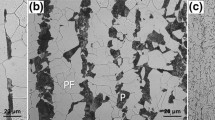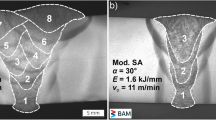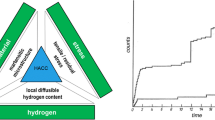Abstract
In present research work, the modified Granjon implant test was performed to evaluate the susceptibility of AISI 8620 and AISI 304 steels toward the hydrogen-assisted cracking. To measure the diffusible hydrogen level (HD) in deposited metal, glycerin method was employed. Shielded metal arc welding process with basic type electrode was used to deposit the metal. The hydrogen was intentionally introduced for the plate of the material AISI 304 by using an oil of grade Society of Automotive Engineers 10, which is of very low viscosity. The heat-affected zone susceptibility was quantified by finding the lower critical stress for a measured hydrogen content.













Similar content being viewed by others
References
X. Yue, X.L. Feng, J.C. Lippold, Quantifying heat-affected zone hydrogen-induced cracking in high-strength naval steels. Weld. J. 92, 265 (2013)
C. Pandey, N. Saini, M.M. Mahapatra, P. Kumar, Hydrogen induced cold cracking of creep resistant ferritic P91 steel for different diffusible hydrogen levels in deposited metal. Int. J. Hydrogen Energy 41(39), 17695 (2016)
C. Pandey, M. M. Mahapatra, P. Kumar, N. Saini, Diffusible hydrogen level in deposited metal and their effect on tensile properties and flexural strength of P91 steel. J. Eng. Mater. Technol. 139(3), 1 (2017)
D. Fydrych, J. Tomków, A. Świerczyńska, Determination of diffusible hydrogen content in the deposited metal of rutile electrodes by the glycerin method. Metall. Foundry Eng. 39(1), 47 (2013)
G. Magudeeswaran, V. Balasubramanian, G. Madhusudhan Reddy, Hydrogen induced cold cracking studies on armour grade high strength, quenched and tempered steel weldments. Int. J. Hydrogen Energy 33(7), 1897 (2008)
P.G. Kumar, K. Yu-ichi, Diffusible hydrogen in steel weldments. Trans. JWRI 42(1), 39 (2013)
X. Yue, Investigation on heat-affected zone hydrogen-induced cracking of high-strength naval steels using the Granjon implant test: HENRY GRANJON PRIZE 2014 Winner Category B: Materials Behaviour and Weldability. Weld. World 59(1), 77 (2014)
A.W. Vasudevan, R. Stout, R.D. Pense, Hydrogen-assisted cracking in HSLA pipeline steels. Weld. J. 60(9), 155 (1981)
D. Fydrych, A. Świerczyńska, G. Rogalski, Effect of underwater wet welding conditions on the diffusible hydrogen content in deposited metal. Metall. Ital. 107(11–12), 47 (2015)
D. Fydrych, G. Rogalski, Effect of shielded-electrode wet welding conditions on diffusion hydrogen content in deposited metal. Weld. Int. 25(3), 166 (2011)
D. Fydrych, J. Łabanowski, An experimental study of high-hydrogen welding processes. Revista de Metalurgia 51(4), 1 (2015)
G.K. Padhy, V. Ramasubbu, S.K. Albert, Rapid determination of diffusible hydrogen in steel welds using a modified gas chromatography facility. J. Test. Eval. 43(1), 69 (2015)
W.P. Campbell, Experiences with HAZ cold cracking tests on a C-Mn structural steel. Weld. Res. (Suppl.) 55(5), 135 (1976)
D.L. Olson, J.L. Davidson, B.F. Dixon, High strength steel for defense applications (TTCP workshop and joint seminar). Volume II: joint seminar papers final report (1997)
C. Pandey, A. Giri, M.M. Mahapatra, P. Kumar, Characterization of microstructure of HAZs in as-welded and service condition of P91 pipe weldments. Met. Mater. Int. 23(1), 148 (2017)
C. Pandey, M.M. Mahapatra, Effect of groove design and post-weld heat treatment on microstructure and mechanical properties of P91 steel weld. J. Mater. Eng. Perform. 25(7), 2761 (2016)
C. Pandey, M.M. Mahapatra, P. Kumar, N. Saini, Effect of normalization and tempering on microstructure and mechanical properties of V-groove and narrow-groove P91 pipe weldments. Mater. Sci. Eng. A 685, 39 (2017)
Author information
Authors and Affiliations
Corresponding author
Rights and permissions
About this article
Cite this article
Yadav, U., Pandey, C., Saini, N. et al. Study on Hydrogen-Assisted Cracking in High-Strength Steels by Using the Granjon Implant Test. Metallogr. Microstruct. Anal. 6, 247–257 (2017). https://doi.org/10.1007/s13632-017-0351-z
Received:
Revised:
Accepted:
Published:
Issue Date:
DOI: https://doi.org/10.1007/s13632-017-0351-z




